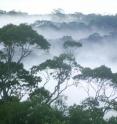Old-growth rainforests must be saved for tropical biodiversity
A team of researchers from Singapore, Australia, Switzerland, the UK and the USA has carried out a comprehensive assessment to estimate the impact of disturbance and land conversion on biodiversity in tropical forests. In a recent study published in Nature, they found that primary forests -- those least disturbed old-growth forests -- sustain the highest levels of biodiversity and are vital to many tropical species. Rampant rates of logging and agricultural expansion have transformed the world's tropical forests, leaving little remaining primary forests unaltered by humans. The value of these rapidly expanding degraded and converted forest landscapes is hotly debated, and was the subject of the study.
"Some scientists have recently argued that degraded tropical forests support high levels of biodiversity," says Luke Gibson, the lead author from the National University of Singapore (NUS). "Our study demonstrates that this is rarely the case," he adds.
Drawing on information from 138 scientific studies spanning 28 tropical countries, Gibson and his colleagues compared biodiversity in primary forests to that in regenerating forests and forests degraded by logging and converted to agriculture. Overall, biodiversity values were substantially lower in disturbed forests.
"There's no substitute for primary forests," says Gibson. "All major forms of disturbance invariably reduce biodiversity in tropical forests," he adds.
Selective logging, in which machinery is used to extract a limited number of trees from the forest, appears to be the least harmful human disturbance. "As selective logging is rapidly expanding throughout the tropics, ecological restoration of such areas might represent an effective strategy to alleviate threats to biodiversity," says Lian Pin Koh of ETH Zurich.
Parks, however, will remain a critical conservation strategy in protecting the world's remaining primary tropical forests. "We urgently need to expand our reserves and improve their enforcement," says Tien Ming Lee, co-lead author at the University of California, San Diego. "Effective reserves have the added benefit of reducing overall carbon emissions," adds Lee.
However, many of these tropical parks are far from secure. "A growing number of reserves are being degraded, downsized, if not entirely degazetted, so holding on to the last remaining large tracts of primary forests within existing reserves will be a crucial part of the conservation mission this century," says Carlos Peres of the University of East Anglia.
Compared to Africa and the Americas, the authors found that tropical forests in Asia suffered the greatest loss in biodiversity. "Southeast Asia, representing most of the Asian studies, emerged as a conservation hotspot and must be one of our top priority regions," suggests Lee. Not surprisingly, Southeast Asia has the lowest remaining forest cover, highest rates of deforestation, and the highest human population densities among all major tropical regions.
This study was initiated by the late Professor Navjot Sodhi, a conservation ecologist at NUS, who devoted his career to studying the biodiversity crisis in Southeast Asia and around the planet.
With the global population projected to surpass 9 billion by 2050, tropical forests will face increasing threats posed by human-driven land-use changes. "Human populations are exploding and very few areas remain untouched by the expanding horizon of human impacts," says Gibson, who was mentored by Professor Sodhi. "It is therefore essential to limit the reach of humans and to preserve the world's remaining old-growth rainforests while they still exist. The future of tropical biodiversity depends on it," he concludes.
Recommend this story on Facebook, Twitter,
and Google +1:
Source: National University of Singapore
Other sources
- Old-growth rainforests must be saved for tropical biodiversityfrom Science DailyThu, 15 Sep 2011, 2:30:29 UTC
- Biodiversity highest in pristine forestsfrom UPIThu, 15 Sep 2011, 0:50:13 UTC
- Biodiversity highest in pristine forestsfrom UPIWed, 14 Sep 2011, 22:00:25 UTC
- Old-growth rainforests vital for tropical biodiversity: studyfrom PhysorgWed, 14 Sep 2011, 17:31:03 UTC
